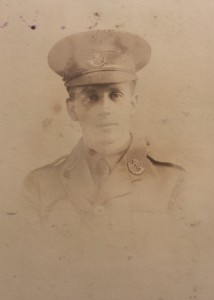Personal Details
Philip Charles Owen was born in Ellesmere, Shropshire on 1 May 1897, the second son of Rev Loftus Meade Owen and Mrs Amy Frances Owen of The Rectory, Stockton, Shifnal, Shropshire. Philip’s father was vicar of St Chad’s Church, Hanmer, Flintshire.
Military Details
Regiment : 9th/5th Battalions King’s Shropshire Light Infantry
Rank : Second Lieutenant
Service Number :
Killed in Action; France 25 September 1915 Aged 18

The 1914 Star (also known as 'Pip') was authorised under Special Army Order no. 350 in November 1917 and by an Admiralty Fleet Order in 1918, for award to officers and men of the British and Indian Expeditionary Forces who served in France or Belgium between 5 August and midnight of 22–23 November 1914. The former date is the day after Britain's declaration of war against the Central Powers, and the closing date marks the end of the First Battle of Ypres.
The 1914–15 Star (also known as 'Pip') was instituted in December 1918 and was awarded to officers and men of British and Imperial forces who served against the Central European Powers in any theatre of the Great War between 5 August 1914 and 31 December 1915. The period of eligibility was prior to the introduction of the Military Service Act 1916, which instituted conscription in Britain.
The British War Medal (also known as 'Squeak') was a silver or bronze medal awarded to officers and men of the British and Imperial Forces who either entered a theatre of war or entered service overseas between 5th August 1914 and 11th November 1918 inclusive. This was later extended to services in Russia, Siberia and some other areas in 1919 and 1920. Approximately 6.5 million British War Medals were issued. Approximately 6.4 million of these were the silver versions of this medal. Around 110,000 of a bronze version were issued mainly to Chinese, Maltese and Indian Labour Corps. The front (obv or obverse) of the medal depicts the head of George V. The recipient's service number, rank, name and unit was impressed on the rim.
The Allied Victory Medal (also known as 'Wilfred') was issued by each of the allies. It was decided that each of the allies should each issue their own bronze victory medal with a similar design, similar equivalent wording and identical ribbon. The British medal was designed by W. McMillan. The front depicts a winged classical figure representing victory. Approximately 5.7 million victory medals were issued. Interestingly, eligibility for this medal was more restrictive and not everyone who received the British War Medal ('Squeak') also received the Victory Medal ('Wilfred'). However, in general, all recipients of 'Wilfred' also received 'Squeak' and all recipients of The 1914 Star or The 1914/1915 Star (also known as 'Pip') also received both 'Squeak' and 'Wilfred'. The recipient's service number, rank, name and unit was impressed on the rim.
Further Information
Report on the death of Philip Charles Owen in De Ruvigny’s Roll of Honour 1914 – 1919
“OWEN, PHILIP CHARLES, 2nd Lieut., 9th (Service) Battn. The King’s (Shropshire Light Infantry), s. of the Rev. Loftus Meade Owen, Rector of Stockton, Shifnal, co. Salop, 1 May, 1897; educ. Millmead, Shrewsbury, and St. Edward’s School, Oxford; was employed in the offices of the Eastern Telegraph Company, Electra House, London, E.C.; joined the Inns of Court O.T.C. 5 Aug. 1914, the day after war was declared; gazetted 2nd Lieut. 9th Battn. The King’s (Shropshire Light Infantry) 5 Oct. 1914, and promoted Lieut.; trained with the 5th Battn., with which he went to France 20 May, 1915, and was killed in action at Bellewaarde Farm, 25 Sept. following, during an attack on the German trenches. The Commanding Officer of the 5th Battn. Lieut-Col. C.C. Barrett wrote:
“Lieut. P.C. Owen was killed on 25 Sept. while gallantly leading his platoon in an attack on the German trenches. I beg to assure you of the sympathy of all ranks of this battalion, who deplore the loss of a brave and efficient officer and a popular man.””
De Ruvigny’s Roll of Honour 1914 – 1918
More information about Philip Charles Owen is available from Flintshire War Memorials.
If you can provide any further information on Philip Charles Owen please get in touch by leaving a comment below, using our Contact Form or by calling in to Whitchurch Heritage Centre.
Information provided by Whitchurch Museum and Archives


